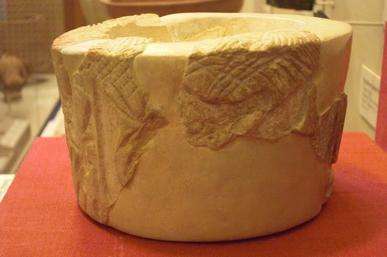Qustul
Qustul is an archaeological cemetery located on the eastern bank of the Nile in Lower Nubia, just opposite of Ballana near the Sudan frontier. The site has archaeological records from the A-Group culture, the New Kingdom of Egypt and the X-Group culture.
Qustul Incense Burner, below, side with hypothesized white crown
 | |
 Shown within Egypt | |
| Location | Aswan Governorate, Egypt |
|---|---|
| Region | Nubia |
| Coordinates | 22°14′0″N 31°37′0″E |
| Type | Archaeological site |
Qustul has been flooded by Lake Nasser.
A-Group records
Three significant A-group culture cemeteries of the times of the First Dynasty of Egypt have been excavated, which is located in present-day Egypt what was once Lower Nubia at least 5800 years ago. The most important one, cemetery L, revealed wealthy burials of rulers. In one of these graves was found an incense burner believed by Bruce Williams of the Oriental Institute at the University of Chicago depicting images assigned to the Pharaoh including a shape he believes to be the White Crown of Upper Egypt.[1]
X-Group records
A necropolis of the X-Group excavated by Walter Emery in 1931-1933 features large grave tumulae with bed burials for the kings with funeral sacrifices of horses, horse trappings and servants from the fourth to the sixth century CE. The royal nature of the burials is confirmed by the presence of bodies which were still wearing their crowns at the time of their discovery.[2]
References
- More info about the Qustul Incense Burner retrieved 30 March 2017
- Derek A. Welsby, The kingdom of Kush: the Napatan and Meroitic empires, chapter 9: The Decline and Fall of the Kushite Kingdom, ISBN 978-1558761827